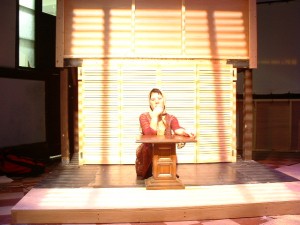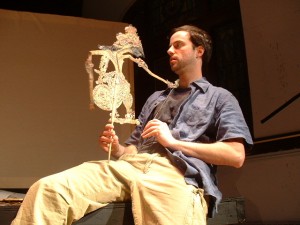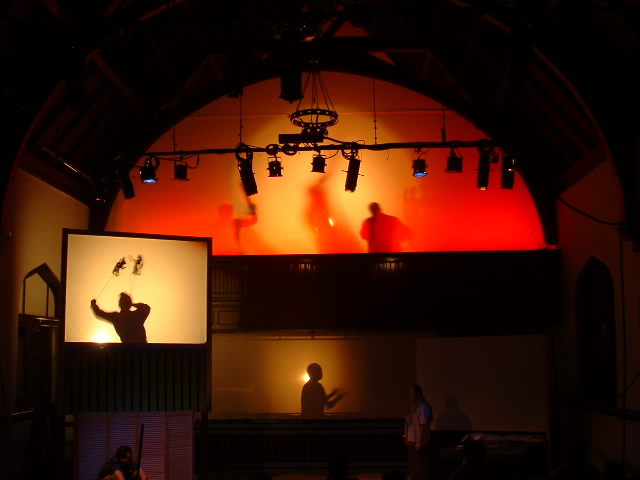 Rorschach, Shedding light on Shadow Puppetry
Rorschach, Shedding light on Shadow Puppetry
By Jane Horowitz
Washington Post
January 20, 2004
“I’ve been talking about it in bars for a long time,” says Randy Baker of “After the Flood,” his play about a Westerner on a spiritual/romantic/coming-of-age quest in Malaysia who encounters wayang kulit, the mystical art of shadow puppetry. So ambitious were his ideas of blending human actors and puppetry that a few years went by before Baker and his co-artistic director at Rorschach Theatre, Jenny McConnell, saw their way to getting it produced.

The small but ambitious experimental company premiered Baker’s play on Saturday and will run it through Feb. 7 at Casa del Pueblo (1459 Columbia Rd. NW). “After the Flood” is a huge undertaking for shoestring-budgeted Rorschach. It tells parallel tales, one human and one a puppet fairy tale. The playing space contains large white screens for the shadow puppets. Backgrounds are projected onto the same screens when human characters take the stage.
Costume and puppet designer Debra Kim Sivigny, scenic designer Matt Soule and sound designer-composer David McKeever traveled to Asia for inspiration. (It helps that playwright Baker also works as a travel agent.) Original puppets were created for “Flood.” McConnell says that despite the mass of details and expense, she knew that “somehow we would figure out how to do it.” Adds Baker, “We jump off a cliff and hope.”
Baker, 29, grew up in Singapore and Malaysia, where his scholarly parents remain and where his paternal grandparents were once missionaries. He repatriated in 1992 to attend the University of Richmond. The play’s protagonist also is an American who grew up in Malaysia and returns to do research on puppetry and, perhaps, to reconnect with a former girlfriend. He hears that a master puppeteer has disappeared, and rumor has it the man simply rose to heaven.

The stories told in wayang kulit are based mostly on Hindu legend, Baker explains, and a master puppeteer can be viewed as “sort of a priest.” He says he’s tried to avoid an urge to lecture his audience, to let the play become merely a travelogue to introduce Westerners to a new culture.
McConnell says they wanted the play to give “this sense of a third-culture kid.” Adds Baker, “the feeling of not belonging — a very familiar sense of alienation.” He says that “writing this play has been about paring down a lot of this . . . and making it about one character’s journey and not an educational biopic.”
Even so, co-director Jeremy Skidmore (of the Theater Alliance) says, “I think most audiences are going to find it completely unique . . . for anyone who hasn’t spent time in Asia. . . . People are going to learn so much.” Skidmore has teamed with James Hart, whom he met in Taiwan in 2000. Skidmore was organizing a theater festival there and Hart was on a fellowship to study ritual masks and dancing, and added puppetry to his research.
He taught four Rorschach actors how to operate the delicate silhouette cutout creations, “how to animate the puppets so they give the illusion of being alive, so they breathe.” The trick: close to the screen for smaller, sharper images, farther back for a bigger, softer-edged view. “I love that there are several different stories that are occurring at once . . . two plays in one,” says Hart, “both of which are epic in proportions.”
